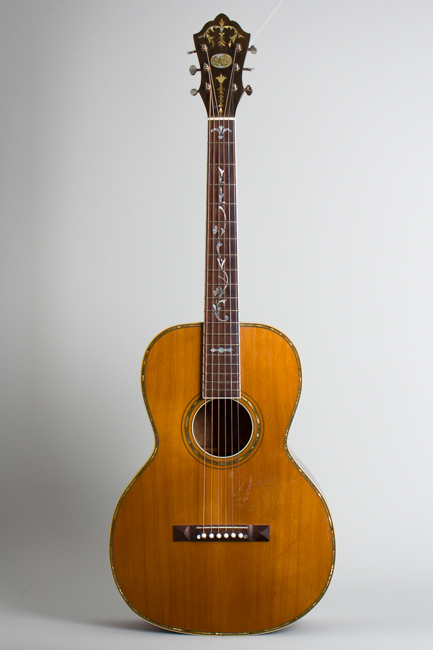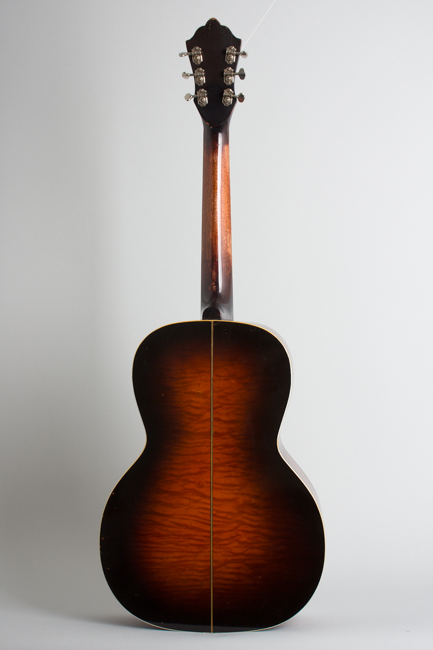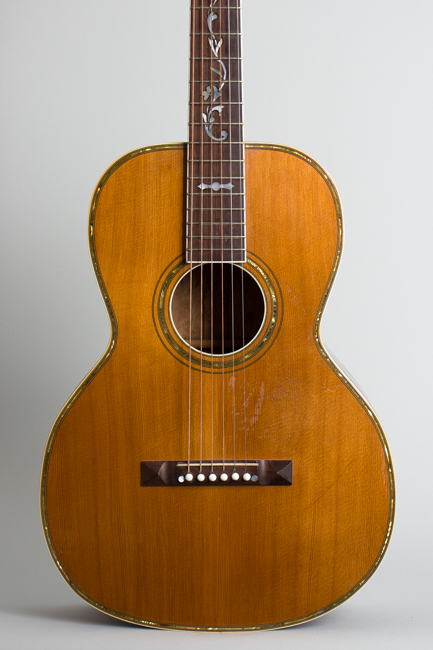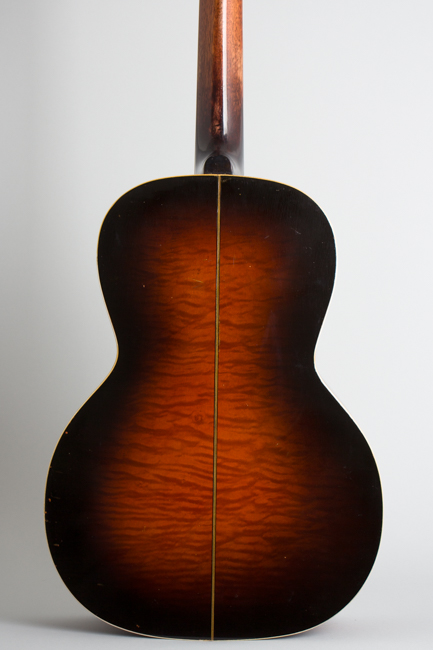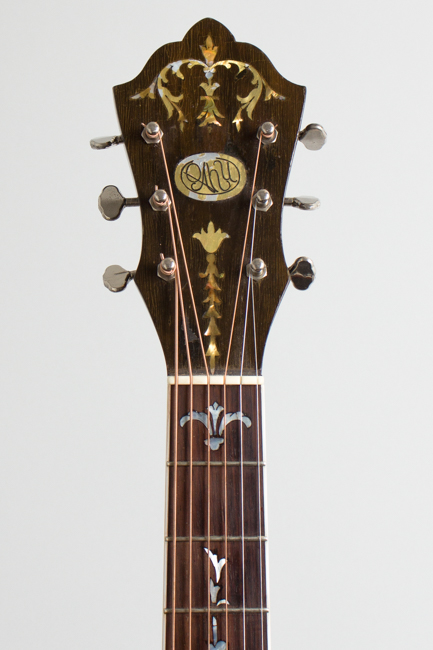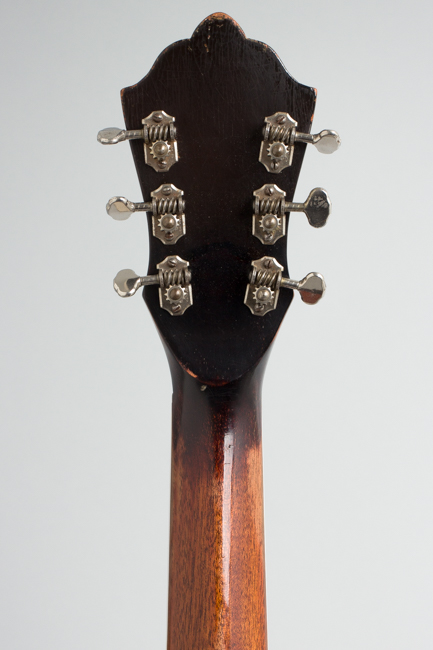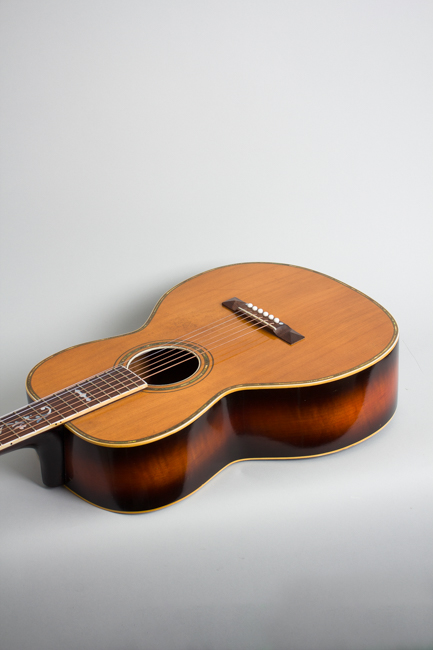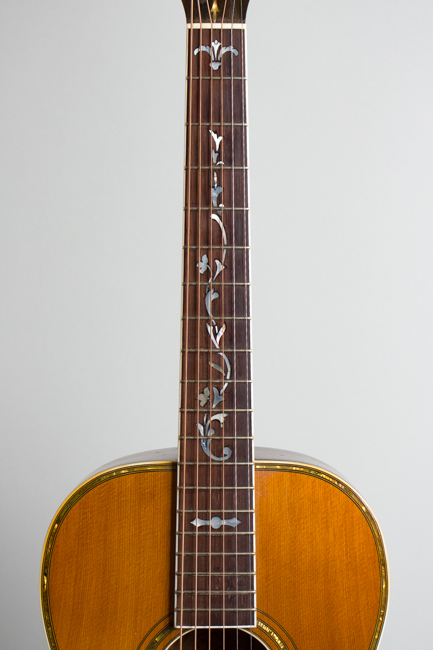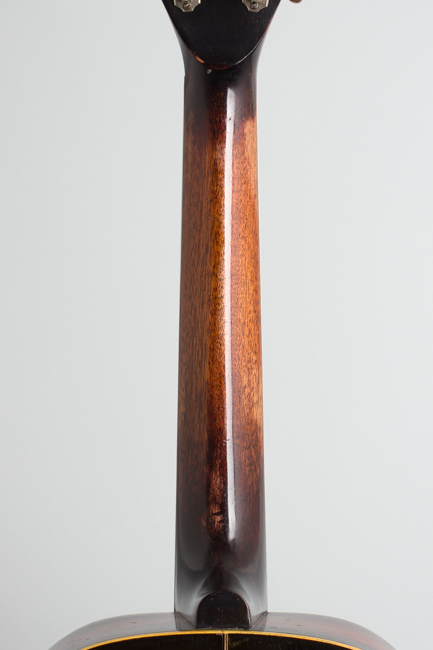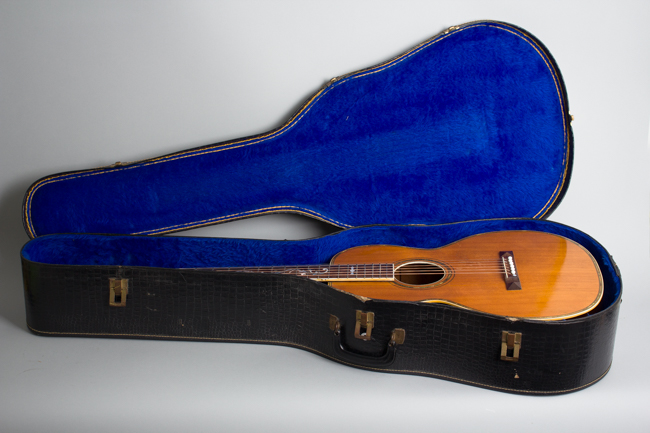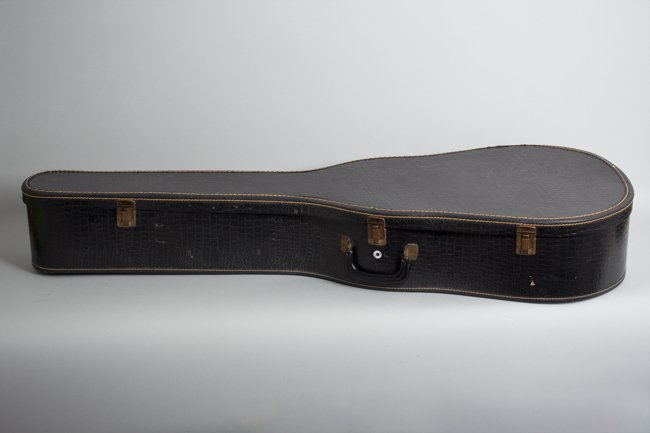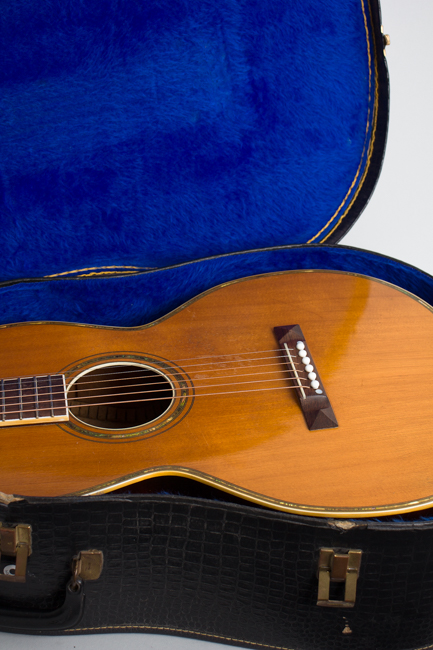Oahu Deluxe Jumbo Style 68 Flat Top Acoustic Guitar (1934)
Oahu Deluxe Jumbo Style 68 Model Flat Top Acoustic Guitar (1934), made in Chicago, sunburst lacquer with stenciling finish, laminated maple back and sides, spruce top; mahogany neck with rosewood fingerboard, black chipboard case.
This pearl-topped Oahu Jumbo guitar is the spectacular looking and very rare first variation of this offbeat Chicago classic with a smaller but deeper body, a long-scale neck and an X-braced top. Made by Kay in Chicago, this is a noticeably superior instrument to the more common later large-bodied, straight-braced version. It was originally built as a Hawaiian guitar and has been converted rather artfully for standard Spanish play. The neck has been reset and reshaped with a fairly authentic-feeling soft "V" profile and refinished; the rest of the guitar remains original.
As their name would imply the Cleveland-based Oahu company specialized in Hawaiian guitar lessons and sheet music, operating a chain of franchised teaching studios across the country. The bulk of their business was printed lessons but they also offered guitars to play them on, usually on a time payment plan. The great majority of instruments made for them were inexpensive Hawaiian guitars; this Deluxe model was ordered in very small numbers. This is one of the earliest first-generation Oahu Jumbos we have seen, the company's top-line instrument in 1933-35. This version was only available for a couple of years before being replaced by a larger full-size Jumbo model.
This guitar's X-braced spruce top is solid spruce finished natural; the back (and probably the sides) are laminated maple with a shaded sunburst finish. The 14 5/8" wide body is nearly 5" deep at the endpin, somewhat akin to Gibson's much-coveted Nick Lucas design offering some of the same sonic character. This guitar has a notably longer scale than the Gibson, however, imparting power and depth to the tone. The top and soundhole ring are bordered in elaborate green abalone, the bound fingerboard has a pearl vine inlay. The fanciful carved headstock is crowned on the face in pearl as well, with the abstract "Oahu" logo etched into a pearl oval.
This guitar was originally sold through Oahu's catalog for a whopping $158.00, an almost incredible sum in 1933-4. "Terms if desired or your present instrument taken in trade" offered Oahu to soften the blow. The non-pearl variant was $98, still quite a price tag in the mid-1930s even if sold on time. These were aggressively touted as a fully professional grade instruments and for that price, had to be. One of the few other flat top guitars priced in the same range would have been a pearl-bordered, Brazilian rosewood Martin 000-45! This version of the Style 68 appears only in the 1933-34 and 1935 Oahu catalogs, with the notation that it is used on the radio by the Oahu Serenaders, the company's sponsored professional group.
The catalog stated the model 68 was "Guaranteed ...as the finest and Best Hawaiian guitar ever manufactured by anyone". The features listed include "Very best Waikiki polished Genuine pearl" with "All pearl work by hand, finished elaborately with extreme caution". The body was supposedly "Made of the finest Hawaiian curly maple" which is pure fantasy, as there is no such wood! "This instrument is guaranteed for a life-time" Oahu added, without specifying whose life-time it was!
Despite this slightly dubious salesmanship (an Oahu trademark) this instrument WAS the finest that Kay in Chicago could build; if perhaps less sophisticated than its Martin or Gibson competitors it remains a super example of one of the 1930s' most distinctive "catalog" guitars. Played as a standard style instrument this guitar has a truly spectacular sound; it has a very powerful response that rings for days with plenty of depth. While perhaps not as subtle or sweet sounding as a Martin of Gibson it has a full-ranging tone with power to spare. This is a lovely example and a delightful instrument to play.
Overall length is 40 1/2 in. (102.9 cm.), 14 5/8 in. (37.1 cm.) wide at lower bout, and 4 5/8 in. (11.7 cm.) in depth at side, taken at the end block. Scale length is 25 3/4 in. (654 mm.). Width of nut is 1 3/4 in. (44 mm.).
This guitar shows some general play wear and an excellent professional conversion from the original Hawaiian format. Just about 90 years along it remains in well-preserved and now excellent playing original condition. There are scuffs, scrapes and dings overall, with some pickwear to the top mostly below and behind the soundhole. Beyond this the original body finish has no heavy areas of loss. The back of the neck has been completely refinished (with a very thin coat of lacquer) and is worn through in several areas; it is hard to say if this was "reliced' on purpose but it looks fairly authentic.
There are no crack repairs to the instrument. The face and most of the back of the headstock retain the original finish, with a bit of flaking on the face. The original early "clipped end" Grover G-98 tuners with riveted gears and "butterbean" buttons are intact and working. The bridge is the original rosewood piece with a non-compensated saddle; internally all the brace work is original with some visible re-gluing and the original maple bridge plate has a small cap on the center line over the pin holes. The retaining bolts have been removed.
The neck has been re-set with a tapered shim under the fingerboard and re-shaped but feels quite period appropriate with a medium "V" profile. No metal rod is apparent, it is possible a graphite one was added (the fingerboard was certainly off for the conversion) but we cannot say for sure. The frets are larger than period spec, both in height and width but not obnoxiously so. The bone nut appears newer, but may be the original bone re-shaped. The fingerboard binding appears original but may have been neatly re-done. This now Spanish neck guitar is very comfortable to play with a powerful upfront sound, a very nice example of one of the 1930s' most distinctive looking guitars and a considerable rarity. Overall Excellent - Condition.
This pearl-topped Oahu Jumbo guitar is the spectacular looking and very rare first variation of this offbeat Chicago classic with a smaller but deeper body, a long-scale neck and an X-braced top. Made by Kay in Chicago, this is a noticeably superior instrument to the more common later large-bodied, straight-braced version. It was originally built as a Hawaiian guitar and has been converted rather artfully for standard Spanish play. The neck has been reset and reshaped with a fairly authentic-feeling soft "V" profile and refinished; the rest of the guitar remains original.
As their name would imply the Cleveland-based Oahu company specialized in Hawaiian guitar lessons and sheet music, operating a chain of franchised teaching studios across the country. The bulk of their business was printed lessons but they also offered guitars to play them on, usually on a time payment plan. The great majority of instruments made for them were inexpensive Hawaiian guitars; this Deluxe model was ordered in very small numbers. This is one of the earliest first-generation Oahu Jumbos we have seen, the company's top-line instrument in 1933-35. This version was only available for a couple of years before being replaced by a larger full-size Jumbo model.
This guitar's X-braced spruce top is solid spruce finished natural; the back (and probably the sides) are laminated maple with a shaded sunburst finish. The 14 5/8" wide body is nearly 5" deep at the endpin, somewhat akin to Gibson's much-coveted Nick Lucas design offering some of the same sonic character. This guitar has a notably longer scale than the Gibson, however, imparting power and depth to the tone. The top and soundhole ring are bordered in elaborate green abalone, the bound fingerboard has a pearl vine inlay. The fanciful carved headstock is crowned on the face in pearl as well, with the abstract "Oahu" logo etched into a pearl oval.
This guitar was originally sold through Oahu's catalog for a whopping $158.00, an almost incredible sum in 1933-4. "Terms if desired or your present instrument taken in trade" offered Oahu to soften the blow. The non-pearl variant was $98, still quite a price tag in the mid-1930s even if sold on time. These were aggressively touted as a fully professional grade instruments and for that price, had to be. One of the few other flat top guitars priced in the same range would have been a pearl-bordered, Brazilian rosewood Martin 000-45! This version of the Style 68 appears only in the 1933-34 and 1935 Oahu catalogs, with the notation that it is used on the radio by the Oahu Serenaders, the company's sponsored professional group.
The catalog stated the model 68 was "Guaranteed ...as the finest and Best Hawaiian guitar ever manufactured by anyone". The features listed include "Very best Waikiki polished Genuine pearl" with "All pearl work by hand, finished elaborately with extreme caution". The body was supposedly "Made of the finest Hawaiian curly maple" which is pure fantasy, as there is no such wood! "This instrument is guaranteed for a life-time" Oahu added, without specifying whose life-time it was!
Despite this slightly dubious salesmanship (an Oahu trademark) this instrument WAS the finest that Kay in Chicago could build; if perhaps less sophisticated than its Martin or Gibson competitors it remains a super example of one of the 1930s' most distinctive "catalog" guitars. Played as a standard style instrument this guitar has a truly spectacular sound; it has a very powerful response that rings for days with plenty of depth. While perhaps not as subtle or sweet sounding as a Martin of Gibson it has a full-ranging tone with power to spare. This is a lovely example and a delightful instrument to play.
Overall length is 40 1/2 in. (102.9 cm.), 14 5/8 in. (37.1 cm.) wide at lower bout, and 4 5/8 in. (11.7 cm.) in depth at side, taken at the end block. Scale length is 25 3/4 in. (654 mm.). Width of nut is 1 3/4 in. (44 mm.).
This guitar shows some general play wear and an excellent professional conversion from the original Hawaiian format. Just about 90 years along it remains in well-preserved and now excellent playing original condition. There are scuffs, scrapes and dings overall, with some pickwear to the top mostly below and behind the soundhole. Beyond this the original body finish has no heavy areas of loss. The back of the neck has been completely refinished (with a very thin coat of lacquer) and is worn through in several areas; it is hard to say if this was "reliced' on purpose but it looks fairly authentic.
There are no crack repairs to the instrument. The face and most of the back of the headstock retain the original finish, with a bit of flaking on the face. The original early "clipped end" Grover G-98 tuners with riveted gears and "butterbean" buttons are intact and working. The bridge is the original rosewood piece with a non-compensated saddle; internally all the brace work is original with some visible re-gluing and the original maple bridge plate has a small cap on the center line over the pin holes. The retaining bolts have been removed.
The neck has been re-set with a tapered shim under the fingerboard and re-shaped but feels quite period appropriate with a medium "V" profile. No metal rod is apparent, it is possible a graphite one was added (the fingerboard was certainly off for the conversion) but we cannot say for sure. The frets are larger than period spec, both in height and width but not obnoxiously so. The bone nut appears newer, but may be the original bone re-shaped. The fingerboard binding appears original but may have been neatly re-done. This now Spanish neck guitar is very comfortable to play with a powerful upfront sound, a very nice example of one of the 1930s' most distinctive looking guitars and a considerable rarity. Overall Excellent - Condition.
